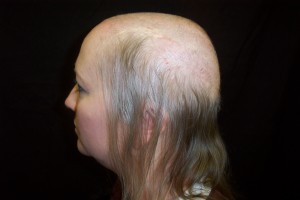A majority of women will experience hair loss at some point in our lives. The causes of hair loss are highly individual, but can include any combination of the following:
Alopecia Areata – an autoimmune disease that causes patches of hair loss, usually on the scalp, but that can affect other areas of the body. Some patients experience a complete loss of scalp hair (Alopecia Totalis) while others have a total loss of all body hair (Alopecia Universalis).
Androgeneic Alopecia – Also known as pattern baldness, this is the most common form of hair loss. Women may experience thinning over the entire scalp, although androgenetic alopecia is generally limited to the front, sides or crown.
Cancer Treatments – Chemotherapy drugs, designed to kill cancer cells, also poison the hair follicles and can result in hair loss that generally starts two to three weeks after the first dose. Hair often grows back three to four months after the last chemo treatment, but it may be thinner, a different color or a different texture. Radiation therapy destroys the ability of cells within its reach to grow and reproduce, and may result in Alopecia.
Hair Products – Chemicals used for coloring, bleaching, straightening or perming hair can cause it to become damaged and broken, and can result in permanent damage if the hair follicle is affected.
Health Changes – Hair loss can by a symptom of undetected health issues, including anemia or thyroid abnormalities, can which can be detected via simple blood tests.
Hormone Changes – Pregnancy, birth control pills and menopause can cause hair loss. Declining estrogen can increase hair-follicle sensitivity to testosterone. As testosterone breaks down, hair follicles may atrophy and stop producing hair.
Stress – Severe physical or emotional stress, such as a death, strenuous sports training, illness, drastic weight loss or surgeries, can cause hair loss. This type of hair loss is usually not permanent, but may last months.
Scarring Alopecia – A condition that results when hair follicles are damaged and replaced with scar tissue.
Tinea Capitis – A ringworm, this fungus that can consume the keratin of the hair, resulting in patches of hair loss. Treatment generally includes an prescription medication and shampoo.
Traction Alopecia – Primarily caused by a pulling force applied to the hair, traction alopecia can be caused by frequently wearing hair in a tight ponytail, pigtails or braids. Hair weaving and extensions can also cause traction alopecia, however Hair Therapy for Women closely monitors its clients for any signs of stress on the hair that extensions or other hair replacement may cause.
Trichotillomania – Trich, or hair-pulling disorder, is an impulse-control disorder that causes people to compulsively pull out strands of hair in distinct patches on the scalp and sometimes other areas of the body, resulting in noticeable bald patches. Anyone with symptoms of Trich should seek help from a licensed, professional psychologist or psychiatrist.


